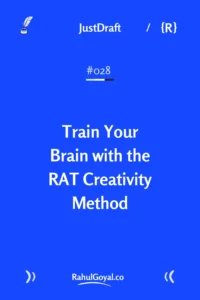How the RAT Test Unlocks Creative Thinking
Ever stared at a blank page waiting for ideas to flow? We’ve all been there. This week, I want to share a simple yet powerful creativity tool that might just help you make those mental leaps: the Remote Associates Test (RAT) or Associate Thinking for Creative Thinking Exercise.
One Topic: RAT Cognitive Test
What is the RAT?
Created by Professor Sarnoff Mednick and Martha T. Mednick back in 1959, the RAT tests your ability to connect seemingly unrelated concepts.
It works like this:
- You see three words that don’t seem connected
- Your job is to find one word that links all three
- Standard format: 30-40 questions in 40 minutes
- Score based on correct answers
Let check through simple example how RAT works:
Given: Fox, Man, Peep
Answer: Hole
The connection? Foxhole, manhole, peephole.
This isn’t just wordplay—it’s exercising your brain’s ability to make unusual connections, which is at the heart of creative thinking.
Why the RAT Matters for Creators
Whether you’re writing code, designing products, or crafting content, the RAT helps you:
- See your creative thinking abilities more clearly
- Get better at connecting different ideas (the foundation of innovation)
- Improve your problem-solving approach
- Track how your creative thinking grows over time
I’ve started using RAT-style exercises before brainstorming sessions, and I’ve noticed my mind stays more flexible and open to unexpected connections.
Making the RAT Work for You
Here’s how to use this tool effectively:
- Practice weekly with 5-10 RAT problems
- Time yourself (start with 2 minutes per problem)
- After solving problems, think about how you found the solutions
- Create your own RAT problems to challenge colleagues
- Use 2-3 problems as a warm-up before creative work
Beyond Words: Visual RAT
For the visually oriented creators, researchers have developed a Visual Remote Associates Test (vRAT). Instead of words, it uses images to test associative thinking. Perfect if your work involves visual design, photography, or illustration.
What Science Says
Research shows RAT performance relates to how effectively we retrieve and connect information from our memory banks. When you tackle these problems, you’re actually training your brain to access its knowledge in more flexible ways.
Last month, I heard in different forums, team solve RAT problems before a brainstorming meeting. The energy and sideways thinking they brought to session afterward was noticeably different—more playful, more willing to explore unusual ideas.
Not the Whole Picture
One important note: the RAT measures associative thinking, which is just one aspect of creativity. It doesn’t capture emotional expression, visual creativity, or many other creative dimensions. Think of it as one useful tool, not the final word on creative ability.
Try It Yourself
Want to test your RAT skills? Try these:
- Cream, Skate, Water
- Loser, Throat, Spot
- Safety, Cushion, Point
(Answers at the bottom of this email)
The RAT isn’t just a test—it’s a window into how our minds connect ideas. Whether you’re stuck on a problem or looking to stretch your creative muscles, give it a try. You might be surprised at what connections your brain can make.
P.S. The answers: 1. Ice (ice cream, ice skate, ice water), 2. Sore (sore loser, sore throat, sore spot), 3. Pin (safety pin, pin cushion, pinpoint)
Read last week’s JustDraft newsletter about Daily Routine of Great Managers.
Two Quotes
Creative breakthroughs happen not when we force connections, but when we create the mental space for unexpected associations to emerge naturally.
The most innovative ideas often arise at the intersection of concepts that seem unrelated until someone has the courage to bridge them.
One Passage From A Book
Vertical thinking is selective, lateral thinking is generative. In vertical thinking one has to be right at each step. In lateral thinking one does not have to be right at each step provided the final solution is right. In vertical thinking one uses the negative in order to block off certain pathways. In lateral thinking there is no negative, one simply tries to explore all pathways. With vertical thinking one selects one approach and works very hard at trying to find a solution along that pathway. With lateral thinking one generates as many alternative approaches as one can.
📚From “Lateral Thinking” by Edward de Bono

